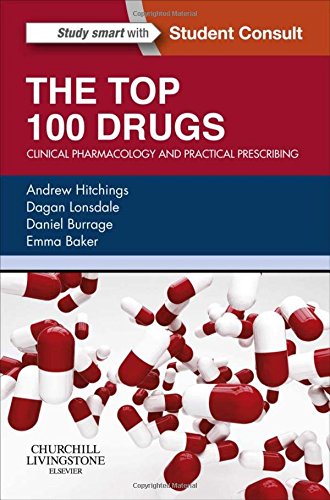The Top 100 Drugs: Clinical Pharmacology and Practical Prescribing 2014
دانلود کتاب پزشکی 100 داروی برتر: فارماکولوژی بالینی و نسخه های عملی
| نویسنده |
Andrew Hitchings, Dagan Lonsdale, Daniel Burrage, Emma Baker |
|---|
| تعداد صفحهها |
266 |
|---|---|
| نوع فایل |
|
| حجم |
34 Mb |
| سال انتشار |
2014 |
89,000 تومان
تجویز دارو برای اولین بار یک تجربه اعصاب خردکن است. از بین تمام وظایفی که پزشکان جدید انجام می دهند، این احتمالاً بیشترین تأثیر را بر رفاه بیماران دارد. عمل ایمن و موثر به درک خوب داروشناسی بالینی و نسخه های عملی بستگی دارد. به دست آوردن این امر آسان نیست، به ویژه هنگامی که با انبوهی از اطلاعات در مورد صدها داروی ناآشنا مواجه می شوید، که اغلب به گونه ای ارائه می شود که به نظر می رسد جدا از واقعیت بالینی باشد.
این کتاب نقطه شروع است. این یک پاسخ مستقیم به درخواست های دانش آموزان برای خلاصه ای از 100 داروی مهم NHS است. اطلاعات کلیدی در مورد فارماکولوژی بالینی و نسخه های عملی برای هر دارو در کنار هم ارائه شده است که به شما امکان می دهد توجه خود را متناسب با مرحله آموزش معطوف کنید. هنگامی که به اطلاعات سریع در مورد بخش ها و با استفاده از سیستم اندام ها یا نشانه های بالینی در زمانی که پشت میز هستید، می توان به داروها بر اساس حروف الفبا دسترسی داشت.
این تحقیق به رهبری پروفسور اما بکر، 100 داروی برتر را به ترتیب اهمیت و دفعات تجویز مشخص کرد. من روشن کردهام که این فهرست در طول زمان کمی تغییر میکند و آن را به منبعی پایدار تبدیل میکند که بر اساس آن یادگیری ایجاد میشود.
“یک منبع عملی عالی برای کسانی که به تازگی متن را تجویز می کنند، برای کسانی است که نسخه های مستقل را تجویز می کنند، و برای آن گروه من آن را در نظر می گیرم. 100 داروی برتر یک انتشار عالی است.”بررسی شده توسط اما واتس، پزشک عمومی در ساری از طرف (مجله) Pulse آوریل 2015
>
- 100 بهترین دارو و پنج مورد برتر مایعات IV با استفاده از یک چیدمان واضح و ثابت در سراسر صفحات دوتایی.
- داروها بر اساس حروف الفبا مرتب شده اند و همچنین توسط سیستم اندام و فهرست شده اند <b نشانه های بالینی مسیرهای متعددی را در اطلاعات ارائه دهید.
- فارماکولوژی بالینی تحت عناوین: نشانه های رایج؛ مکانیسم های عمل؛ اثرات نامطلوب قابل توجه؛ هشدارها و تعاملات مهم
- دستورالعمل های عملی آنها تحت عناوین مورد بحث قرار می گیرند: نسخه ها; مدیریت؛ مخابرات؛ تماشا کردن و هزینه
- توصیه های بالینی برای هر دارو ارائه شده است.
- بهترین پاسخ های فردی ارائه شده است برای ارزیابی خود و نشان دادن نحوه ترکیب اطلاعات از چندین دارو.
Prescribing for the first time is a nerve-wracking experience. Of all the tasks performed by new doctors, it is probably the one with greatest direct impact on the wellbeing of patients. Safe and effective practice rests on a good understanding of both clinical pharmacology and practical prescribing. Acquiring this is not easy, particularly when faced with reams of information about hundreds of unfamiliar drugs, often presented in a way that appears detached from clinical reality.
This book is your starting point. It is a direct response to requests from students for a compendium of the 100 most important drugs in the NHS. Key information about the clinical pharmacology and practical prescribing of each drug is presented side-by-side, allowing you to direct your attention as appropriate for your stage of training. Drugs can be accessed alphabetically when you need quick information on the wards and by organ system or clinical indication when you are at your desk.
Research led by Professor Emma Baker has identified the top 100 drugs by their importance and prescribing frequency. She has shown that the list changes little over time, making it a stable resource upon which to base learning.
"A great practical resource for those new to prescribing the text is aimed at those new to independent prescribing, and for that group I would consider. The Top 100 Drugs to be an excellent publication." Reviewed by Emma Watts, GP in Surrey on behalf of (journal) Pulse April 2015
"This handy, pocket-sized book is a great practical resource for those new to prescribing." Reviewed by Pulse, Apr 2015
- The top 100 drugs and the five most important intravenous fluids are presented using a clear, consistent layout across double-page spreads.
- Drugs are arranged alphabetically and also listed by organ system and clinical indication, providing multiple pathways into the information.
- Clinical pharmacology is discussed under the headings: common indications; mechanisms of action; important adverse effects; warnings; and important interactions.
- Practical prescribing is discussed under the headings: prescription; administration; communication; monitoring; and cost.
- A clinical tip is presented for every drug.
- Single-best-answer questions are provided for self-assessment and to show how information from several drugs may be integrated.



